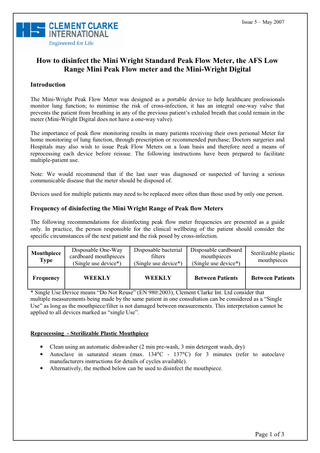HS CLEMENT CLARKE INTERNATIONAL
HS CLEMENT CLARKE INTERNATIONAL Peak Flow Meters
Mini-Wright Disinfection Instructions Issue 5 May 2007
Disinfection Instructions
3 Pages

Preview
Page 1
Issue 5 – May 2007
How to disinfect the Mini Wright Standard Peak Flow Meter, the AFS Low Range Mini Peak Flow meter and the Mini-Wright Digital Introduction The Mini-Wright Peak Flow Meter was designed as a portable device to help healthcare professionals monitor lung function; to minimise the risk of cross-infection, it has an integral one-way valve that prevents the patient from breathing in any of the previous patient’s exhaled breath that could remain in the meter (Mini-Wright Digital does not have a one-way valve). The importance of peak flow monitoring results in many patients receiving their own personal Meter for home monitoring of lung function, through prescription or recommended purchase; Doctors surgeries and Hospitals may also wish to issue Peak Flow Meters on a loan basis and therefore need a means of reprocessing each device before reissue. The following instructions have been prepared to facilitate multiple-patient use. Note: We would recommend that if the last user was diagnosed or suspected of having a serious communicable disease that the meter should be disposed of. Devices used for multiple patients may need to be replaced more often than those used by only one person.
Frequency of disinfecting the Mini Wright Range of Peak flow Meters The following recommendations for disinfecting peak flow meter frequencies are presented as a guide only. In practice, the person responsible for the clinical wellbeing of the patient should consider the specific circumstances of the next patient and the risk posed by cross-infection. Mouthpiece Type
Disposable One-Way cardboard mouthpieces (Single use device*)
Disposable bacterial filters (Single use device*)
Disposable cardboard mouthpieces (Single use device*)
Sterilizable plastic mouthpieces
Frequency
WEEKLY
WEEKLY
Between Patients
Between Patients
* Single Use Device means “Do Not Reuse” (EN 980:2003), Clement Clarke Int. Ltd consider that multiple measurements being made by the same patient in one consultation can be considered as a “Single Use” as long as the mouthpiece/filter is not damaged between measurements. This interpretation cannot be applied to all devices marked as “single Use”. Reprocessing - Sterilizable Plastic Mouthpiece • • •
Clean using an automatic dishwasher (2 min pre-wash, 3 min detergent wash, dry) Autoclave in saturated steam (max. 134°C - 137°C) for 3 minutes (refer to autoclave manufacturers instructions for details of cycles available). Alternatively, the method below can be used to disinfect the mouthpiece.
Page 1 of 3
Issue 5 – May 2007
Cleaning & Disinfection
1
Inspect the unit for signs of damage or wear, if any is evident replace meter.
2
Prepare a solution of detergent in accordance with the manufacturer instructions in a container large enough for the Peak Flow Meter(s) to be totally submerged.
Detergent
Agitate the meter whilst in the solution to ensure any trapped air is expelled. Do not use any mechanical aids such as brushes or cloths.
3 Leave in solution for recommend time
Rinse and dry as recommended.
4 Rinse as recommended
5
6
Disinfectant
Leave in solution for recommend time
Prepare a quantity of your chosen disinfectant in a suitable container.
Immerse the Peak Flow Meter, again agitate the meter to ensure air is expelled and leave it in the solution for the recommended time
Rinse as recommended
7 Dry naturally
Rinse as stated, shake gently to remove any excess water and allow to dry naturally, do not use hot air or a drying cupboard.
Page 2 of 3
Issue 5 – May 2007
Detergents The following detergents have been tested for compatibility with Clement Clarke Int. Ltd’s, Peak Flow Meters.v Name
Solution strength 40 ml in 5 litres of water
Lancerzyme Cidezyme Hospec
Comments Enzymatic cleaner Enzymatic cleaner
Disinfectants The following disinfectants have been tested for compatibility with Clement Clarke Int. Ltd, Peak Flow Meters at the stated concentrations only. Chemical type
Examples
Solution strength 20ml in 1 litre of water
Chlorine dioxide generator
Tristel one day
ortho-phthalaldehyde
Cidex OPA
Undiluted
Sodium hypochlorite (NaOCL)
Milton,
1000 ppm
Sodium dichloroisocyanurate (NaDCC) Hydrogen peroxide and peroxygen componds
Presept, Actichlor Sanichlor, Haz-Tab
1000 ppm
Pera Safe,
1.62% w/volume
• •
•
•
Comments Safety data sheet and further information available from www.tristel.com Ensure thorough rinsing, as corrosion of the metal parts will occur if exposed to chlorine for long periods.
Clement Clarke Int. Ltd accepts no liability for damage caused to products if the above procedure and recommended solutions are not used. It is the users responsibility to choose which of the recommended solutions are used within their establishment or hospital and we stress that the infection control nurse/department should be consulted when making the choice. It is the responsibility of the user to keep themselves current with the latest information from the relevant disinfectant manufacturer concerning instructions, effects, concentrations, and immersion times. If your preferred cleaner/disinfectant is not on the recommended list please contact our customer service advisors on 01279 414969 or Fax 01279 456 304 or Email [email protected].
References: Chemical disinfection in hospitals – PHLS, Sterilization, disinfection and cleaning of medical device equipment (MAC Manual) – MHRA
Page 3 of 3